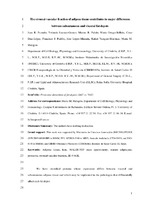The stromal-vascular fraction of adipose tissue contributes to major differences between subcutaneous and visceral fat depots
Autor
Peinado, Juan R.
Jiménez Gómez, Yolanda
Pulido, Marina R.
Ortega-Bellido, María
Díaz-López, César
Padillo, Francisco
López Miranda, José
Vazquez-Martínez, Rafael
Malagón, María M.
Editor
WileyFecha
2010Materia
Adipose tissueMature adipocytes
Cell types
Stromal-vascular fraction (SVF)
Proteomic profile
Molecular basis
Metabolic syndrome
Lipodystrophy
METS:
Mostrar el registro METSPREMIS:
Mostrar el registro PREMISMetadatos
Mostrar el registro completo del ítemResumen
Adipose tissue represents a complex tissue both in terms of its cellular composition, as it includes mature adipocytes and the various cell types comprising the stromal-vascular fraction (SVF), and in relation to the distinct biochemical, morphological and functional characteristics according to its anatomical location. Herein, we have characterized the proteomic profile of both mature adipocyte and SVF from human visceral adipose tissue (VAT) and subcutaneous adipose tissue (SAT) fat depots in order to unveil differences in the expression of proteins which may underlie the distinct association of VAT and SAT to several pathologies. Specifically, 24 proteins were observed to be differentially expressed between SAT SVF versus VAT SVF from lean individuals. Immunoblotting and RT-PCR analysis confirmed the differential regulation of the nuclear envelope proteins lamin A/C, the membrane-cytoskeletal linker ezrin and the enzyme involved in retinoic acid production, aldehyde dehydrogenase 1A2, in the two fat depots. In sum, the observation that proteins with important cell functions are differentially distributed between VAT and SAT and their characterization as components of SVF or mature adipocytes pave the way for future research on the molecular basis underlying diverse adipose tissue-related pathologies such as metabolic syndrome or lipodystrophy.

